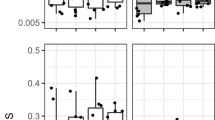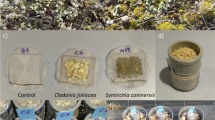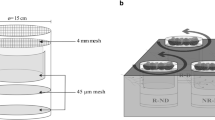Abstract
Humulus japonicus in communities of Miscanthus sacchariflorus and Phragmites australis can grow large enough to overtop other species in the Amsa-dong floodplain. Because of strong winds and the weight of Humulus, plants of M. sacchariflorus and P. australis fell in mid-August and were subject to decomposition under its dense shading. To assess the effects of H. japonicus on nutrient cycling in these communities, we collected fresh samples of M. sacchariflorus and P. australis in litterbags and decomposed them under H. japonicus for 9 months, beginning in August. Biomass and organic contents from M. sacchariflorus during this incubation period were 49–51% and 44–48%, whereas those of P. australis were 49–61% and 32–52%, respectively. Their annual k values were 1.61–1.74 and 1.46–3.54, respectively. Initial N concentrations in M. sacchariflorus and P. australis were 13 and 20 mg g−1, while C:N ratios were 31 and 21, respectively. These results indicate that H. japonicus is responsible for the collapse of M. sacchariflorus and P. australis in August and also accelerates their nutrient cycling through rapid decomposition, thereby increasing nutrient circulation in floodplains.




Similar content being viewed by others
References
Anderson JM (1973) The breakdown and decomposition of sweet chestnut (Castanea sativa Mill.) and beech (Fagus silvatica L.) leaf litter in two deciduous woodland soils: II. Change in carbon, hydrogen, nitrogen and polyphenol content. Oecologia 12:275–288
Bae KH (2000) The medicinal plants of Korea. Kyo-Hak Publishing Co., Seoul
Berg B, Laskowski R (2006) Litter decomposition: a guide to carbon and nutrient turnover. Academic, UK, pp 116–118
Berg B, Wessen B, Ekbohm G (1982) Nitrogen level and decomposition in Scots pine needle litter. Oikos 38:291–296
Boyd CE (1970) Losses of mineral nutrients during decomposition of Typha latifolia. Arch Hydrobiol 66:511–517
Boyle J (2004) A comparison of two methods for estimating the organic matter content of sediments. J Paleolimnol 31:125–127
Brinson MM (1977) Decomposition and nutrient exchange of litter in an alluvial swamp forest. Ecology 58:601–609
Buth GJC (1987) Decomposition of roots of three plant communities in a Dutch salt marsh. Aquat Bot 29:125–138
Chamie JP, Richardson CJ (1978) Decomposition in northern wetlands. In: Good RE, Whigham DF, Simpson RL (eds) Freshwater wetlands. Academic, New York, pp 115–130
Cotrufo MF, Ineson P, Rowland AP (1994) Decomposition of the tree leaf litter grown under elevated CO2: effect of litter quality. Plant Soil 163:121–130
Davis CB, van der Valk AG (1978) The decomposition of standing and fallen litter of Typha glauca and Scirpus fluviatilis. Can J Bot 56:662–675
Dean WE Jr (1974) Determination of carbonates and organic matter in calcareous sediments and sedimentary rocks by loss on ignition: comparison with other methods. J Sediment Petrol 44:242–248
Ehara K (1955) Comparative morphological studies on the hop (Humulus lupulus L.) and the Japanese hop (H. japonicus Sieb. et Zucc.). J Fac Agric Kyushu Univ 10(4):209–237
Gholz HZ, Perry CS, Cropper WP, Hendry JR, Hendry LC (1985) Litterfall, decomposition and nitrogen and phosphorus dynamics in a chronosequence of slash pine (Pinus elliottii) plantation. Forest Sci 31:463–478
Godshalk GL, Wetzel RG (1978) Decomposition of aquatic angiosperms: III. Zostera marina L. and a conceptual model of decomposition. Aquat Bot 5:329–354
Hackney CT, de la Cruz AA (1980) In situ decomposition of roots and rhizomes of two tidal marsh plants. Ecology 61:226–231
Hammer DA (1995) Water quality improvement functions of wetlands. In: Nierenberg WA (ed) Encyclopedia of Environmental Biology. Academic, San Diego, pp 485–561
Hemminga MA, Kok CJ, de Munck W (1988) Decomposition of Spartina anglica roots and rhizomes in a salt marsh of the Westerschelde Estuary. Mar Ecol Prog Ser 48:175–184
Ju EJ, Kim JG, Lee YW, Lee BA, Kim HT, Nam JM, Kang HJ (2006) Growth rate and nutrient content changes of Humulus japonicus. J Ecol Field Biol 29(5):461–467
Kelly JM, Beauchamp JJ (1987) Mass loss and nutrient changes in decomposition of upland oak and mesic mixed-hardwood leaf litter. Soil Sci Soc Am J 51:1616–1622
Kim JG (2001) Decomposition of Carex and Nuphar plants in a subalpine marsh. J Plant Biol 44(2):73–80
Kim SR, Kim JG, Ju EJ, Lee YW, Lee BA, Kim HT, Nam JM (2006) Losses of biomass and mineral nutrients during decomposition of herbaceous plants in riverine wetlands. J Ecol Field Biol 29(5):469–478
Lee TB (1980) Illustrated flora of Korea. Hyangmunsa, Seoul
Mason CF, Bryant RJ (1975) Production, nutrient content and decomposition of Phragmites australis Trin. and Typha angustifolia L. J Ecol 63:71–95
Mckane RB, Rastetter EB, Shaver GR, Nadelhoffer KJ, Gibli AE, Laundre JA, Chapin FS III (1997) Climate effects on tundra carbon storage inferred from experimental data and a model. Ecology 78:1170–1187
Mosse B, Hayman DS, Arnold J (2006) Plant growth responses to vesicular-arbuscular mycorrhiza. V. Phosphate uptake by three plant species from P-deficient soil labeled with 32P. New Phytol 72(4):809–815
Mun HT, Jeong NG, Kim JH (2000) Mass loss and changes of nutrients during decomposition of Phragmites australis at the fringe stream. Kor J Ecol 23(2):157–161
Planter M (1970) Elution of mineral components out of dead reed Phragmites australis Trin. Pol Arch Hydrobiol 17:357–362
Polunin NVC (1982) Process contributing to the decay of reed (Phragmites australis) litter in fresh water. Arch Hydrobiol 94:182–209
Pozo J, Colino R (1992) Decomposition process of Spartina maritima in a salt marsh of the Basque country. Hydrobiologia 231:165–175
Seoul City (2001) Close investigation of natural ecosystems. Seoul (in Korean)
Seoul City (2003) Ecological monitoring and management plan in bam island ecological preservation area. Seoul (in Korean)
Seoul City (2005) Ecological monitoring and management plan in amsadong ecological preservation area. Seoul (in Korean)
Shim K-C, Kang K-M, Chang M-K (1996) The removal rates of the constituents of litters in the littoral grassland ecosystems in the Lake Paldangho: I. Organics. Kor Turfgrass Sci 10:143–150
Smith RL, Smith TM (2001) Ecology and field biology. Benjamin Cummings, San Francisco
Swift MJ, Heal OW, Anderson JM (1979) Decomposition in terrestrial ecosystems, study in ecology, vol 5. University of California Press, Berkeley, CA
Valiela I, Wilson J, Buchsbaum R, Rietsma C, Bryant D, Foreman K, Teal J (1984) Importance of chemical composition of salt marsh litter on decay rates and feeding by detritivores. Bull Mar Sci 35:261–269
van der Valk AG, Attiwill PM (1984) Decomposition of leaf and root litter of Aricennia marina at Western Bay, Victoria, Australia. Aquat Bot 18:205–221
Wrubleski DA, Murkin HR, van der Valk AG, Nelson JW (1997) Decomposition of emergent macrophyte roots and rhizomes in a northern prairie marsh. Aquat Bot 58:121–134
Zang Q, Zak JC (1995) Effects of gap size on litter decomposition and microbial activity in a subtropical forest. Ecology 76:2196–2204
Acknowledgements
We thank Heungtae Kim, Jong Min Nam, Jihyun Yoon, and Sungje Jeon for assistance with the fieldwork. This work was supported by the Korean Ministry of Environment as “The Eco-technopia 21 Project” titled “Evaluation of Ecological Impacts of Invasive Vine-plants on Biodiversity and Ecological Function in Riverine Ecosystems and Development of Management Strategy”, as well as by a Korean Research Foundation Grant funded by the Korean Government (MOEHRD; KRF-2007-313-C00735).
Author information
Authors and Affiliations
Corresponding author
Rights and permissions
About this article
Cite this article
Kim, S., Kim, J.G. Humulus japonicus Accelerates the Decomposition of Miscanthus sacchariflorus and Phragmites australis in a Floodplain. J. Plant Biol. 52, 466–474 (2009). https://doi.org/10.1007/s12374-009-9060-8
Received:
Revised:
Accepted:
Published:
Issue Date:
DOI: https://doi.org/10.1007/s12374-009-9060-8




